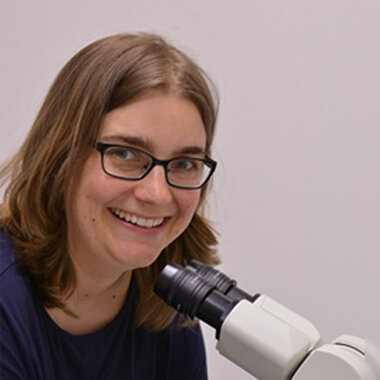Integrating transcriptional data and cellular function
Simone Mayer, PhD, group leader at the Hertie Institute for Clinical Brain Research in Germany, has moved around the world pursuing a career studying neurotransmitters. At each location she has felt that the environment shapes how she experiences life, leading her to chase after the question: How does what we are exposed to shape who we are?

Simone Mayer, PhD, explains how using multimodal analysis helped reveal new insights into human brain development
Simone Mayer, PhD, group leader at the Hertie Institute for Clinical Brain Research in Germany, has moved around the world pursuing a career studying neurotransmitters. At each location she has felt that the environment shapes how she experiences life, leading her to chase after the question: How does what we are exposed to shape who we are?
“This kind of interrelation of space and time and how it influences my brain is something that fascinates me,” she said.
On a quest for answers at the molecular level, Mayer investigates how stem cells generate neurons and how these neurons attain their final roles and functionality during gestation. In the prenatal brain, stem cells generate diverse cell types, and newborn neurons respond to signaling cues, including neurotransmitters.
“When the babies are born, their neural circuits are established, and they can interact with their environment,” she said. “How does this development work during pregnancy? And, as we have much larger brains and greater cellular diversity compared to mice, how do the stem cells in human brains achieve this?”
Recently, she has been able to get a little closer to answering these questions. In a paper published in Neuron by researchers at the University of California, San Francisco (UCSF), Mayer reports a multimodal analysis to differentiate cells beyond transcriptomic classification. Using the Fluidigm C1™ and Polaris™ systems, Mayer and her team members were able to link physiological information and transcriptomics in human primary cells. This allowed a better understanding of individual neural cell function, because cell type-specific responses to neurotransmitters are associated with this maturation.
Mapping physiological response patterns onto cellular diversity
While numerous single-cell RNA sequencing (scRNA-seq) studies have uncovered great cellular diversity, physiological heterogeneity has yet to be mapped onto these developing cell types due to technical challenges. Mayer was able to confront many of these challenges, including isolating and perturbing single cells in a controlled environment, monitoring and measuring the response and linking this response measurement to transcriptome analysis using the Polaris microfluidics-based approach.
Using Polaris, Mayer was able to combine the measurements of intracellular calcium levels in response to neurotransmitter receptor agonists and scRNA-seq data from the same single cells.
“It's mind-blowing, being able to look at two features in the same single cell with minimal time delay,” she said.
To narrow the number of agonists to be used in the functional experiments, Mayer used a dataset that had been built by the lab of Arnold Kriegstein, MD, PhD, of UCSF from full-length mRNA sequencing of the same cell types on the C1 system. Mayer used Polaris to actively select single cells of interest and hold them in individual, environmentally controlled microfluidic reaction chambers. By combining information from both datasets, she could observe when specific cell types in a certain state had varying responses to the different agonists.
Deploying highly controlled perturbations, the team discovered that calcium responses are cell type-specific and change dynamically as stem cells differentiate to diverse types of neurons. Additionally, Mayer and her colleagues observed cellular diversity not captured by single-cell mRNA sequencing alone. For example, they found a specific serotonin receptor that selectively activates radial glia cells (a type of stem cell) in the developing human brain, but not the mouse brain. Further, inhibiting this receptor in the human brain disrupts the radial glial scaffold, a mechanism for new neurons to travel to their final destination. In the study, they also show neurotransmitter signaling during neurogenesis and highlight potential mechanisms in the evolution of physiological signaling.
“In the human brain, there's a larger diversity of different types of stem cells than in the mouse,” Mayer said. “We knew that in mice there were some neurotransmitters that would have an effect on a certain class of stem cells, but it wasn't really clear which of these subtypes had responses to neurotransmitters in the mouse, and even less so in the human brain. Combining the physiological readouts with RNA sequencing allowed us to really identify different stem cell states that responded to a certain agonist.”
Polaris is the solution to enable researchers to understand the functional heterogeneity of cell populations characterized by single-cell mRNA sequencing.
Applications beyond neurology
Many intracellular messenger molecules exist that, like calcium, can mediate the responses in many cellular signaling pathways. In immunology and cancer applications, intracellular messengers could easily be used as proxies for response to an agonist.
“This approach is highly versatile and could be used for pretty much any organ system in any biological question in mammalian cells. I think that a great next application would be to use a different intracellular indicator, for example, for pH levels,” she said. “I think it's one of these instruments that's very nice to have downstream of assessing single-cell transcriptomics studies—especially when you have a good hypothesis—that allows you to explore functional signaling pathways at the single-cell level.”
Mayer is also contemplating other multimodality studies, such as combining scRNA-seq and physiological data with epigenetics.
“I think this is a very basic question we are trying to answer about what’s a cell type and what’s a cell state, which I think is widely debated at the moment in the field,” Mayer said. “For example, how different do two cells have to be in order to be evolutionarily distinct cell types? I believe multimodal studies at the single-cell level will be crucial for achieving a meaningful definition of a cell type.”
Unless explicitly and expressly stated otherwise, all products are provided for Research Use Only, not for use in diagnostic procedures. Find more information here.
